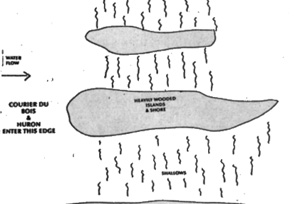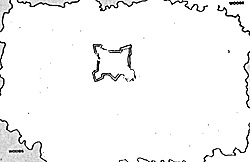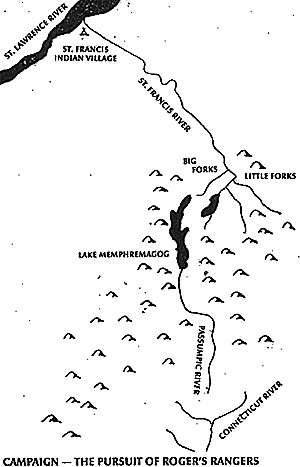On this side of the Atlantic the start of the Seven-Year's War only legitimized a running war which had been continuing for almost a century between the English and French colonists and their respective native allies. War-parties, raids, hijackings, were all part and parcel of the competitive fur trade. This article intends to explore some of the fascinating opportunities these conflicts offer the wargamer. The scenarios offered can be used with any good set of skirmish or small unit rules. Our group used our own skirmish rules or The Sword and the Flame rules, with great success.
SCENARIO 1 - IROQUOIS HIJACKING
 The beaver is not a very smart creature. One can easily tell where he lives and one hole in his dam is sure to bring him out and into the jaws of a trap. This meant that at the height of the North American fur trade the beaver was hunted to extinction in many areas. Such an area was the Iroquois home-lands. However, unlike the Huron who could move west and north to trade for the pelts and become a profitable middleman in the industry, the Iroquois were hemmed in by the English to the east, and the French and their Indian allies to the north and west. Unable to obtain the pelts through usual channels, the Iroquois turned to hijacking.
The beaver is not a very smart creature. One can easily tell where he lives and one hole in his dam is sure to bring him out and into the jaws of a trap. This meant that at the height of the North American fur trade the beaver was hunted to extinction in many areas. Such an area was the Iroquois home-lands. However, unlike the Huron who could move west and north to trade for the pelts and become a profitable middleman in the industry, the Iroquois were hemmed in by the English to the east, and the French and their Indian allies to the north and west. Unable to obtain the pelts through usual channels, the Iroquois turned to hijacking.
The war parties would make their way up the Richelieu River via Lake Champlain, bypass Montreal and set up across the Ottawa River to await the fur convoys heading form Montreal and Quebec City. This route became so traveled that it became known as the "back door to New France" or "Warpath of Nations". The Iroquois were so successful in this campaign that in 1652 not one beaver pelt made it, via the Ottawa River, to the docks at Quebec City. This raiding of fur convoys continued sporadically, against Hurons and coureurs-du-bois right up to the English conquest of New France.
However, the Ottawa is a deep and wide river. There are only a few choice locations suitable for an ambush. Portages, were popular: Chaudiere Falls, just west of the present-day Canadian Parliament Buildings, must have seen a skirmish or two.
But my favorite is a few more miles up river, where the waters shallow to pass between two islands. The Champlain Bridge links Ottawa to Hull at this point, today. The depth is such that canoes would run aground unless the paddlers got out and "walked" the vessels 'over the shallows, which run for a couple of hundred yards. The Iroquois would hide in the bushes on the bank and charge when the Hurons left their canoes. The poor paddler had a choice of holding on to his precious canoe full of prime pelts and tryng to fight with one hand or letting the prize drift down river and fight with two hands. Down river, around the bend, a young Iroquois boy would gleefully pull in the abandoned treasures.
THE WARGAME
The Huron/Coureurs-du-bois should outnumber the Iroquois moderately - say 3:2. There should be a good assortment of weapons - bows, warclubs; knives and only a few muskets. 2 to 4 Hurons/French in each canoe.
The Iroquois player secretly notes where his braves are hiding. Using a sketch map, the Huron player draws lines representing the path of each canoe. Dragging the canoes through the shallows should be painfully slow and random ,say l die roll of inches pe rturn. Running through the shallows: try 2 die X inches. Canoes drifting with the flow and swimming in deep water, also 2 die X inches.
Figures cannot shoot or throw weapons while holding onto a canoe and hand-to-hand with a significant penalty (we use -20% in our skirmish rules).
Victory conditions: Every canoe that drifts off the board is considered captured by the Iroquois. 1 victory point for every canoe a side owns at the end of the game. 2 victory points for every casualty inflicted on the enemy.
SCENARIO 2 - THE STAND OF DOLLARD DES ORMEAUX
 Because of the Iroquois war parties, or perhaps in spite of them, Adam Dollard des Ormeaux led a small party out of Ville-Marrie (Montreal), up the Ottawa River, in May of 1660. There is some debate as to Dollard's intent. Romantics claim he was set on clearing the Ottawa of the raiding iroquois. The more logical speculation would be that his party was going to hijack some Iroquois shipments of pelts headed for Albany and New York or to do some trapping of its own, lured by the high price of pelts in VilleMame.
Because of the Iroquois war parties, or perhaps in spite of them, Adam Dollard des Ormeaux led a small party out of Ville-Marrie (Montreal), up the Ottawa River, in May of 1660. There is some debate as to Dollard's intent. Romantics claim he was set on clearing the Ottawa of the raiding iroquois. The more logical speculation would be that his party was going to hijack some Iroquois shipments of pelts headed for Albany and New York or to do some trapping of its own, lured by the high price of pelts in VilleMame.
Whatever the reason, the party did not get very far. Shortly after leaving its base camp (an abandoned fort at Long Sault on the western tip of Montreal Island), the group of 17 Frenchmen, 44 Hurons and Algonquins ran smack into an Iroquois war party of 200-300 warriors heading toward Ville-Marrie. The natives in Dollard's group immediately defected to the enemy or melted into the woods. The Frenchmen scurried back to the abandoned fort.
Over the next week the small group held out against 300 Iroquois and the 500 or so Mohawks and Oneidas which arrived mid-week. Finally, the fort was overrun and the inhabitants killed or captured and later tortured to death. There is some speculation that the, Iroquois were, in fact, heading for Ville-Marrie, intent on its destruction. If that ws so, the valiant stand of Dollard and his men probably saved the infant colony, for the Iroquois and their allies went home after the siege without attacking Ville-Marrie.
THE WARGAME
17 Frenchmen armed with good quality muskets and lots of ammunition. WHOLE BUNCHES of Iroquois armed with wood shields, war clubs and a minimum of poor quality muskets or bows (we use 80 on the table at the beginning of any rush).
The table should have a small fort placed in the center. Remember this was an abancloned fort so the walls can be crossed (or crawled through) without scaling ladders (we make them spend 1 turn at the wall). I could not find out how much of a clear field of fire. Dollards men had. We give them lot-. they need it. Only the edges of the table give the Iroquois any concealment.
Iroquois Morale: The Iroquois player secretly rolls 10 dice and notes the total. When his casualties and wounded reach that total, his braves retreat to cover. The French re-order, bind the wounded and wait for the next rush.
ROGER'S RANGER 1759
A CAMPAIGN GAME
 HOW MANY RUSHES CAN YOU STAND?
HOW MANY RUSHES CAN YOU STAND?
It is related that Major Rogers, driven to the verge of madness by returning home to find his wife and children murdered and scalped by Abenakis or St. Francis Indians, sought and obtained from General Amherst at Crown Point, command of an expedition to wreak vengeance on the perpetrators of this and other atrocities.
The Indian village of St. Francis was situated at the mouth of the St. Francis River, half way between Quebec and Montreal.
With 200 Provincials Rogers embarked at Crown Point in "Bateaux" and proceeded down Lake Champlain. On the fifth day the force was reduced to 142 men due to an accidental explosion of a keg of gunpowder, the wounded being sent back to Crown Point.
Boats and provisions were concealed at Mississquoi Bay, leaving two men on guard. The Rangers then struck off through swamp and wilderness, but were overtaken on the second day by the men left to guard the boats. A large party of French and Indians had discovered the boats and provisions and were in hot pursuit. Several men were dispatched to inform General Amherst of what had taken place, with a request that provisions be sent to Coos on the Connecticut river, by which route Rogers intended to return.
With no alternative they pushed on to St. Francis, arriving in sight of the Indian village on October 4th, 1759. The natives were holding a grand celebration and dance. On high poles were suspended scalps of all sizes, sexes and ages, taken in various raids by these Indians on settlements in New England.
The Rangers attacked the village at daybreak. Taken by surprise the natives were mercilessly slain, without regard to age or sex. Of 300 inhabitants, 200 were slain, several taken prisoner and some English captives recovered. The village was reduced to ashes. Roil call revealed one Ranger killed and 7 wounded. Taking what plunder was of value, they started to retreat up the St. Francis River. Pursued by about 100 Indians on foot and in canoes, they were several times attacked in the rear. On gaining an elevated point above Big Forks (now Sherbooke, Que.), an ambush was planned. A detail was sent to make fires at Little Forks (Lennoxville) and then rejoin the main body. Indian scouts reported Rogers -in camp at Little Forks. As the Indians rounded a bend in the river they were perfect targets for the Rangers. Almost every Indian was killed or wounded; also the Indians on shore lost many before retreating. Only a few Rangers were killed or hurt.
According to Barnes, a recovered captive, when it was decided to make a stand against the Indians at Big Forks, a small party of which he was a member was detailed to carry the cumbersome treasure to a point on the Connecticut River, but on hearing the guns and doubtful of their comrades' success in repulsing their enemies, buried the treasure and hastened on. Tradition has assigned various localities as their hiding place, Next day, ordering prisoners to be shot, Rogers resigned command, advising dividing into small companies to afford a better chance for game, as provisions were entirely gone. All were to meet at the appointed place on the Connecticut River. Rogers and several men took the way of Lake Memphremagog and the Passumpic River. One party was overtaken by Indians at Castle Brook and massacred. Three others were captured at Potton.
They suffered incredible hardships and starvation. It is said some even ate human flesh and others died of hunger before they reached the appointed place where they were to find provisions - only to find smoking embers. The relief party, having become terrified at the sound of firing, returned home.
Weak and discouraged, Rogers and three others built a raft to descend the river but at the first rapids it was lost. They barely escaped being drowned. They built another raft with effort almost beyond their strength and managed to pass a second rapids to float down stream to civilization and assistance.
THE WARGAME CAMPAIGN
The above account can serve as the basis of an interesting campaign. The gamestarts on October 5th, 1759 - the day after the attack on the village of St. Francis and the chase continues until Rangers are all killed or reach the Connecticut River.
Each side should start with equal numbers of figures. You can use your own scale but we found 5 to 1 worked well - giving each player 28 figures in his original force. The Rangers should be armed with rifled flintlocks and hunting knives. The natives should have a variety of clubs, tomahawks, knives, smoothbore muskets and bows (each native should have at least one missile weapon). Each pair of figures travels in a canoe. Canoes may be abandoned in favor of tripling up in canoes, if you wish (this is not quite historic in that Rogers' men traveled mostly by foot - but it is a lot of fun).
Map movement is handled by dice rolls. Give the Rangers 20 millimeters head start on the accompanying map (enlarged to at least 8.5' X 11'). Each turn the Rangers move 3D6 worth of millimeters and the pursuing Indians move 5D6 worth. If the Rangers wish to bury the treasure they may move 4 dice worth. Once the natives catch up to the Rangers a table-top battle is resolved.
Before each battle it must be determined whether it is a running canoe battle or if the Indians were able to sneak up on the Rangers' overnight camp, Roll a D6: 1-4 = a running canoe battle; 5-6 = set-piece attack on the Rangers' camp. Set-piece attacks are set up in the usual way but running battles are more involved and interesting. Start the two canoe forces just within musket range of each other. Figures should be able to paddle or handle firearms but not both. You may have one figure load or fire as the others in the canoe paddle, but this should obviously be slower than when all occupants paddle. May I also suggest that canoe movement ranges be random, otherwise once the Rangers are out of range there is no hope of catching them. Melees in canoes should be short and decisive (as anyone who has tried to stand up in a canoe can tell you).
After each battle the Rangers are advanced 20mm on the map and the chase them resumes. The Rangers' force will dwindle as their casualties mount but the pursuing Indians should always return to their original figure.
Any turn, instead of moving, the Rangers may set up an ambush, as they did at Big Forks. There is a chance, however, that the ambush will be discovered. Roll a D6 5-6 and the ambush is discovered resulting in a setpiece battle instead of an ambush, Each subsequent ambush that is attempted causes 1 to be added to the die roll. You may have your own ambush or surprise rules, but as a suggestion we give the Rangers a free shot and the Indians take a reaction test as "surprised". If the Rangers win the ambush encounter (you'll have to decide on victory conditions) they move 40 millimeters before the change resumes. Otherwise advance the usual 20mm and continue the chase.
VICTORY CONDITIONS
More than 1/2 of the Rangers' party returns to Connecticut River WITH the plunder MAJOR RANGER VICTORY
More than 1/2 of Rangers return MINOR RANGER VICTORY
Less than 1/2 of Rangers return MINOR INDIAN VICTORY
None or almost none return MAJOR INDIAN VICTORY
BIBLIOGRAPHICAL REFERENCES
Ontario Historical Society - historic sites plaque, Ottawa, Ontario
Herstein, Huges, Kirbyson, "Challenge & Survival: The History of Canada"
S. Zanini, "Canadian Military Figures - Adam Dollard des Ormeaux"
The Canadian Wargamers journal, Vol. 1, No. 4 Day, "History of the Eastern Townships"
Rev. E.M. Taylor, "History of Brome County", Brome County Historical Society
Back to Table of Contents -- Courier Vol. VIII No. 4
To Courier List of Issues
To MagWeb Master Magazine List
© Copyright 1988 by The Courier Publishing Company.
This article appears in MagWeb (Magazine Web) on the Internet World Wide Web.
Other military history articles and gaming articles are available at http://www.magweb.com